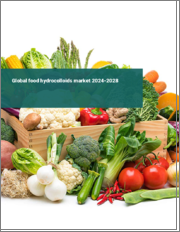
|
시장보고서
상품코드
1490890
세계의 식품용 하이드로콜로이드 시장 규모 - 유형, 용도, 공급원별 및 예측(2024-2032년)Food Hydrocolloids Market Size - By Type, Application, Source & Forecast, 2024 - 2032 |
||||||
식품용 하이드로콜로이드 시장 규모는 2024년부터 2032년까지 연평균 4.1% 이상 성장할 것으로 예상됩니다.
식품 배합물의 유변학적 특성을 수정하고 제어할 수 있는 능력으로 인해 식품용 하이드로콜로이드는 원하는 관능적 특성과 제품 기능성을 달성하는 데 필수적인 역할을 합니다.
식품에서 클린 라벨 및 유기농 재료로의 전환이 증가함에 따라 합성 첨가물의 대안으로 식물 및 미생물에서 추출한 하이드로콜로이드에 대한 관심이 높아졌습니다. 예를 들어, 2024년 3월 인그리디언은 NOVATION Indulge 2940 전분을 출시하여 클린 라벨 텍스처라이저 제품군을 확대했습니다. 이 새로운 최초의 비 GMO 기능성 옥수수 전분은 인기 있는 유제품, 대체 유제품 및 디저트의 겔화 및 공동 텍스처링에 독특한 질감을 제공합니다.
하이드로콜로이드의 가공 및 응용 분야의 기술 발전과 혁신 증가는 시장 성장을 더욱 촉진하고 있습니다. 제조업체들은 식품 분야의 다양한 요구를 충족시키기 위해 하이드로콜로이드 원료의 기능성, 안정성 및 다용도성을 향상시키기 위해 연구개발에 투자하고 있습니다. 효소 변형 및 마이크로 캡슐화와 같은 첨단 가공 기술은 성능과 저장 안정성이 향상된 하이드로콜로이드 원료의 제조를 가능하게 하여 다양한 식품 제형에 대한 적용을 확대하고 있습니다.
식품용 하이드로콜로이드 산업은 유형, 공급원, 용도, 지역별로 구분됩니다.
유형에 따라 구아검 부문 시장 규모는 독특한 특성과 식품 배합물에서 다양한 용도로 인해 2024년부터 2032년 사이에 4.8%의 성장률을 보일 것으로 예상됩니다. 구아검은 우수한 농축, 안정화 및 유화 특성으로 유명하며 식품 제조업체들 사이에서 인기있는 선택으로 부상하고 있습니다. 다른 하이드로콜로이드와 달리 구아검은 뛰어난 점성과 저온 조건에서 안정성을 보여 유제품, 베이커리, 소스, 음식 및 음료 등 다양한 식품에 적합합니다.
용도별로는 식감 개선, 안정성 및 유통기한 연장에 대한 수요 증가로 인해 일용품 및 냉동 제품 부문의 식품용 하이드로콜로이드 시장은 2032년까지 연평균 3.5%의 성장률을 보일 것으로 예상됩니다. 하이드로콜로이드는 요구르트, 치즈, 아이스크림과 같은 유제품의 점도, 질감 및 입맛을 개선하고 전반적인 관능적 매력을 향상시키는 데 도움이 됩니다. 이 제품은 또한 냉동 디저트 및 편의 식품의 수분 이탈 및 얼음 결정 형성을 방지하고 저장 및 유통을 통해 제품의 품질과 일관성을 보장하는 데 도움이 됩니다.
유럽의 식품용 하이드로콜로이드 산업은 2024년부터 2032년까지 연평균 3.3%의 성장률로 유리한 기회를 창출할 것으로 예측됩니다. 유럽 소비자들은 인공 성분과 방부제가 없는 식품을 점점 더 많이 찾고 있으며, 이는 클린 라벨을 강조하는 천연 하이드로콜로이드의 채택을 촉진하고 있습니다. 식품 제조를 관리하는 규제 기준과 품질 요구 사항이 강화됨에 따라 고품질 하이드로콜로이드 원료의 채택이 더욱 촉진되어 이 지역 시장 성장에 유리하게 작용할 것으로 예상됩니다.
목차
제1장 조사 방법과 조사 범위
제2장 주요 요약
제3장 업계 인사이트
- 생태계 분석
- 밸류체인
- 주요 제조업체
- 시장 참여 루트
- 주요 유통업체
- 새로운 유통 채널
- 업계 전체 이익률
- 업계에 대한 영향요인
- 성장 촉진요인
- 시장이 해결해야 할 과제
- 시장 기회
- 신시장/용도
- 성장 가능성 분석
- 원재료 상황
- 제조 동향
- 기술 진화
- 지속가능한 제조
- 그린 프랙티스
- 탈탄소화
- 니이하라료
- 원재료 가격 동향(달러/톤)
- 미국
- 유럽연합
- 영국
- 중국
- 동남아시아
- GCC 국가
- 제조 동향
- 규제와 시장에 대한 영향
- 무역 통계
- 미충족 요구
- Porter's Five Forces 분석
- PESTEL 분석
제4장 경쟁 구도
- 기업 점유율 분석
- 경쟁 포지셔닝 매트릭스
- 전략 전망 매트릭스
제5장 시장 규모와 예측 : 유형별, 2018년-2032년
- 주요 동향
- 젤라틴 껌
- 펙틴
- 잔탄검
- 구아검
- 카라기난
- 기타
제6장 시장 규모와 예측 : 공급원별, 2018년-2032년
- 주요 동향
- 식물
- 동물성
- 해조
- 합성
- 미생물
제7장 시장 규모와 예측 : 용도별, 2018년-2032년
- 주요 동향
- 베이커리 및 제과
- 유제품 및 냉동식품
- 음료
- 고기 및 어개류
- 기타 용도
제8장 시장 규모와 예측 : 지역별, 2018년-2032년
- 주요 동향
- 북미
- 미국
- 캐나다
- 유럽
- 독일
- 영국
- 프랑스
- 이탈리아
- 스페인
- 기타 유럽
- 아시아태평양
- 중국
- 인도
- 일본
- 한국
- 호주
- 기타 아시아태평양
- 라틴아메리카
- 브라질
- 멕시코
- 아르헨티나
- 기타 라틴아메리카
- 중동 및 아프리카
- 사우디아라비아
- 아랍에미리트(UAE)
- 남아프리카공화국
- 기타 중동 및 아프리카
제9장 기업 개요
- Ashland Global Holdings Inc.
- Cargill, Incorporated
- CP Kelco
- DuPont de Nemours, Inc.
- FMC Corporation
- Gum Technology Corporation
- Ingredion Incorporated
- Kerry Group plc
- Koninklijke DSM N.V.
- Lonza Group AG
- Tate & Lyle PLC
- TIC Gums, Inc.
Food hydrocolloids market size is projected to expand at over 4.1% CAGR from 2024 to 2032, owing to the rising adoption for convenience foods and processed products. The ability to modify and control the rheological properties of food formulations is making food hydrocolloids indispensable for achieving desired sensory attributes and product functionalities.
The growing shift towards clean-label and organic ingredients in food products has led to the exploration of hydrocolloids derived from plant and microbial sources as alternatives to synthetic additives. For instance, in March 2024, Ingredion introduced NOVATION Indulge 2940 starch to expand its range of clean label texturizers. This new first-ever non-GMO functional corn starch provides a unique texture for gelling and co-texturizing for popular dairy and alternative dairy products and desserts.
Growing technological advancements and innovations in hydrocolloid processing and applications is further driving the market growth. Manufacturers are investing in R&D to enhance the functionality, stability, and versatility of hydrocolloid ingredients for catering to the diverse needs of the food sector. Advanced processing techniques, such as enzymatic modification and microencapsulation is also enabling the production of hydrocolloid ingredients with improved performance and shelf stability, expanding its applications in various food formulations.
The food hydrocolloids industry is segmented into type, source, application and region.
Based on type, the market size from the guar gum segment is slated to witness 4.8% growth rate during 2024-2032, due to its unique properties and versatile applications in food formulations. Guar gum is known for its excellent thickening, stabilizing, and emulsifying properties, emerging as a popular choice among food manufacturers. Unlike other hydrocolloids, guar gum exhibits exceptional viscosity and stability in cold conditions, making it suitable for a wide range of food products, including dairy, bakery, sauces, and beverages.
In terms of application, the food hydrocolloids market from the diary & frozen products segment will grow at 3.5% CAGR through 2032, due to its increasing demand for texture enhancement, stability, and shelf-life extension. Hydrocolloids help in improving the viscosity, texture, and mouthfeel of dairy products, such as yogurt, cheese, and ice cream while enhancing their overall sensory appeal. These products also aid in preventing syneresis and ice crystal formation in frozen desserts and convenience foods for ensuring product quality and consistency throughout storage and distribution.
Europe food hydrocolloids industry is projected to generate lucrative opportunities at 3.3% CAGR during 2024-2032, attributed to the increasing consumer preference for clean-label and natural food products. European consumers are increasingly seeking food products free from artificial ingredients and preservatives, driving the adoption of natural hydrocolloids with clean-label appeal. Growing stringent regulatory standards and quality requirements governing food production will further drive the adoption of high-quality hydrocolloid ingredients, favoring the regional market growth.
Table of Contents
Chapter 1 Methodology & Scope
- 1.1 Market scope & definition
- 1.2 Base estimates & calculations
- 1.3 Forecast calculation
- 1.4 Data sources
- 1.4.1 Primary sources
- 1.4.2 Data mining sources
- 1.4.2.1 Paid sources
- 1.4.2.2 Public sources
Chapter 2 Executive Summary
- 2.1 Industry 360 degree synopsis
- 2.2 Type trends
- 2.3 Source trends
- 2.4 Application trends
- 2.5 Regional trends
Chapter 3 Industry Insights
- 3.1 Industry ecosystem analysis
- 3.1.1 Value chain
- 3.1.2 Key manufacturers
- 3.1.3 Go to market routes
- 3.1.4 Key distributors
- 3.1.4.1 New distribution channels
- 3.1.5 Profit margins across the industry
- 3.2 Industry impact forces
- 3.2.1 Growth drivers
- 3.2.2 Market challenges
- 3.2.3 Market opportunities
- 3.2.3.1 New markets/applications
- 3.2.3.2 Growth potential analysis
- 3.3 Raw material landscape
- 3.3.1 Manufacturing trends
- 3.3.1.1 Technology evolution
- 3.3.1.2 Sustainable manufacturing
- 3.3.1.2.1 Green practices
- 3.3.1.2.2 Decarbonization
- 3.3.2 New raw materials
- 3.3.3 Raw material pricing trends (USD/Ton)
- 3.3.3.1 U.S.
- 3.3.3.2 European Union
- 3.3.3.3 UK
- 3.3.3.4 China
- 3.3.3.5 Southeast Asia
- 3.3.3.6 GCC
- 3.3.1 Manufacturing trends
- 3.4 Regulations & market impact
- 3.5 Trade statistics
- 3.6 Unmet needs
- 3.7 Porter's analysis
- 3.8 PESTEL analysis
Chapter 4 Competitive Landscape, 2023
- 4.1 Company market share analysis
- 4.2 Competitive positioning matrix
- 4.3 Strategic outlook matrix
Chapter 5 Market Size and Forecast, By Type, 2018-2032 (USD Billion, Kilo Tons)
- 5.1 Key trends
- 5.2 Gelatin gum
- 5.3 Pectin
- 5.4 Xanthan gum
- 5.5 Guar gum
- 5.6 Carrageenan
- 5.7 Others
Chapter 6 Market Size and Forecast, By Source, 2018-2032 (USD Billion, Kilo Tons)
- 6.1 Key trends
- 6.2 Plant
- 6.3 Animal
- 6.4 Seaweed
- 6.5 Synthetic
- 6.6 Microbial
Chapter 7 Market Size and Forecast, By Application, 2018-2032 (USD Billion, Kilo Tons)
- 7.1 Key trends
- 7.2 Bakery and confectionery
- 7.3 Dairy and frozen products
- 7.4 Beverages
- 7.5 Meat and seafood products
- 7.6 Other applications
Chapter 8 Market Size and Forecast, By Region, 2018-2032 (USD Billion, Kilo Tons)
- 8.1 Key trends
- 8.2 North America
- 8.2.1 U.S.
- 8.2.2 Canada
- 8.3 Europe
- 8.3.1 Germany
- 8.3.2 UK
- 8.3.3 France
- 8.3.4 Italy
- 8.3.5 Spain
- 8.3.6 Rest of Europe
- 8.4 Asia Pacific
- 8.4.1 China
- 8.4.2 India
- 8.4.3 Japan
- 8.4.4 South Korea
- 8.4.5 Australia
- 8.4.6 Rest of Asia Pacific
- 8.5 Latin America
- 8.5.1 Brazil
- 8.5.2 Mexico
- 8.5.3 Argentina
- 8.5.4 Rest of Latin America
- 8.6 MEA
- 8.6.1 Saudi Arabia
- 8.6.2 UAE
- 8.6.3 South Africa
- 8.6.4 Rest of MEA
Chapter 9 Company Profiles
- 9.1 Ashland Global Holdings Inc.
- 9.2 Cargill, Incorporated
- 9.3 CP Kelco
- 9.4 DuPont de Nemours, Inc.
- 9.5 FMC Corporation
- 9.6 Gum Technology Corporation
- 9.7 Ingredion Incorporated
- 9.8 Kerry Group plc
- 9.9 Koninklijke DSM N.V.
- 9.10 Lonza Group AG
- 9.11 Tate & Lyle PLC
- 9.12 TIC Gums, Inc.













